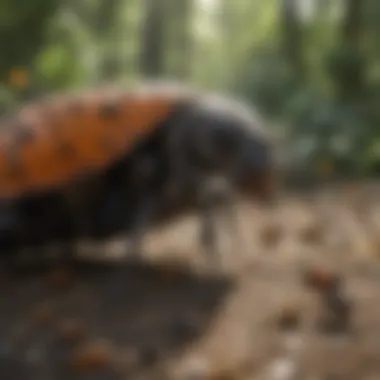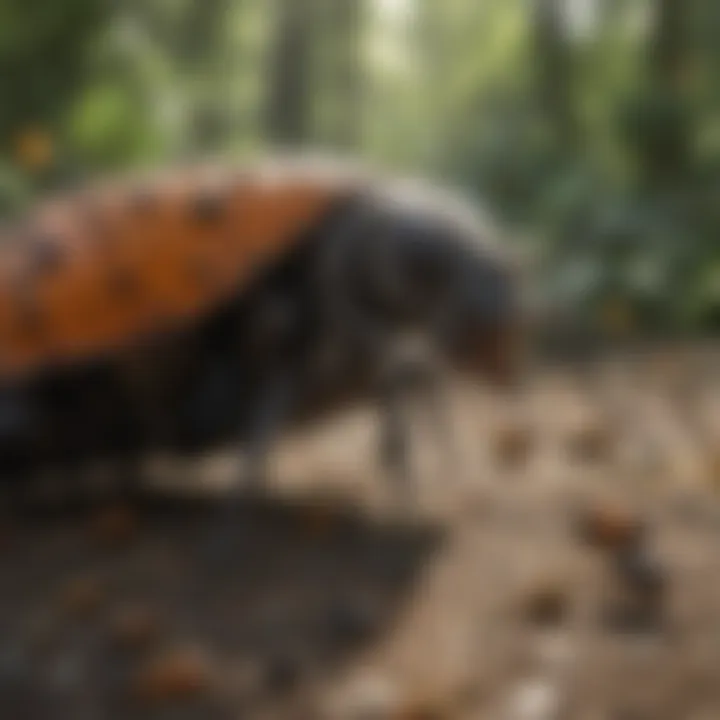Understanding the Benefits of Swarm Pests in Ecosystems


Intro
Swarm pests often evoke negative reactions among homeowners, primarily due to their potential to cause damage or spread disease. However, a nuanced understanding of these creatures reveals an intricate web of ecological benefits. In today’s ecosystems, swarm pests play roles that can enhance biodiversity and contribute to the balance of their environments.
This article aims to shed light on the advantages of swarm pests. It delves into their ecological functions, their importance in promoting biodiversity, and how they interact with other species. Such insights are valuable, particularly for individuals charged with maintaining a pest-free environment while being mindful of ecological balance.
Through exploring the significant aspects that swarm pests offer, readers will gain a more informed perspective on pest management strategies. Ultimately, the knowledge gained here can empower homeowners to navigate pest-related challenges with a more holistic view.
Prelims to Swarm Pests
Understanding swarm pests is crucial for appreciating their role in ecosystems. These insects, often viewed as nuisances, can actually have beneficial impacts on their surroundings. Their functions extend beyond mere annoyance, as they contribute to ecological balance and health. Swarm pests can serve various roles, from decomposing matter to promoting soil health. They affect biodiversity, influencing both plant and animal life. Thus, an informed perspective on swarm pests allows for better management strategies that can enhance both agricultural productivity and ecosystem richness.
Defining Swarm Pests
Swarm pests are defined as insects that exhibit collective behavior, forming large groups during certain life stages or environmental conditions. This behavior usually involves a migration or foraging pattern, enabling them to exploit available resources more efficiently. Common traits include communication systems, such as pheromones, which help maintain social organization within the swarm. Recognizing these traits allows us to appreciate not just the identity of these pests but also their impact on the environments they inhabit.
Types of Swarm Pests
Swarm pests can be categorized into various types, each playing distinct ecological roles. Here are some significant examples:
Termites
Termites are crucial decomposers in their ecosystems. They break down cellulose found in wood and plant materials, recycling nutrients back into the soil. Their tunneling behavior also aerates the soil, aiding water absorption and root growth. A key characteristic of termites is their social structure, where workers perform essential tasks for colony survival. This organization makes termites a beneficial choice for understanding ecological dynamics, as they help maintain soil health. However, infestations in homes can lead to significant structural damage.
Ants
Ants are another notable group of swarm pests. They are vital for seed dispersal and the control of other insect populations. Ant colonies exhibit incredible versatility, adapting to various environments. Their key characteristic is their ability to form complex societies, which enhances their survival. In terms of benefits, ants create networks that improve soil quality and contribute to the food web. Although they can become pests in households, their ecological contributions cannot be overlooked.
Bees
Bees, often admired for their role in pollination, are essential for many ecosystems. They facilitate the reproduction of flowering plants, which in turn supports diverse animal life. A key feature of bees is their specialized behavior toward flowers; they have co-evolved with many plants to optimize pollen transfer. This relationship is beneficial to agriculture and biodiversity. The downside is their decreasing populations, which pose a risk to many ecosystems and food supplies.
Locusts
Locusts are unique among swarm pests due to their capacity for formation in swarms that can devastate crops. Their swarming behavior is often a response to environmental stress. The key characteristic of locusts is their ability to transition from solitary to gregarious phases, altering behavior and appearance. While often viewed negatively for their destructive swarms, locusts contribute to nutrient cycling when they die and decompose, enhancing soil fertility. Therefore, understanding their lifecycle and behavior is important for managing their impact.
Swarm pests, whether beneficial or detrimental, play significant roles in their respective ecosystems, shaping environmental health and dynamics.
Ecological Roles of Swarm Pests
Swarm pests play significant roles in maintaining ecological balance and supporting various environmental processes. Understanding these roles allows homeowners and professionals to appreciate the advantages that these often-maligned insects provide. This section will delve into specific ecological functions swarm pests perform, emphasizing their contributions to ecosystems at large.
Decomposers in the Ecosystem
Decomposers are essential in recycling nutrients back into the environment. Swarm pests, such as certain ants and termites, contribute to decomposition. They break down organic matter, which is crucial for soil health.
When fallen leaves and dead animals accumulate, swarm pests transform this organic waste. They feed on it and, in the process, enrich the soil with nutrients. This activity fosters plant growth and ensures a diverse range of flora and fauna can thrive in their natural habitat. Homeowners may find that their gardens flourish as a result of this intricate process, demonstrating how swarm pests benefit not only nature but also human interests.
Soil Aeration and Nutrient Cycling
Soil quality is intrinsically tied to its structure and composition. Swarm pests contribute to this by aerating the soil through their burrowing and tunneling activities. Termites, for example, create channels in the earth which allows air, water, and nutrients to permeate more effectively. This aeration is vital in promoting healthy root development for plants.
Moreover, as swarm pests move through the soil, they facilitate nutrient cycling. The fecal matter from these insects enriches the soil further with organic compounds. This symbiotic relationship between swarm pests and the ecosystem exemplifies how they impact agricultural productivity. Homeowners can benefit from healthier soil and better plant yields due to the crucial roles played by these pests.
Food Web Contributions


In any ecosystem, food webs reflect the complex interdependencies among species. Swarm pests serve as prey for a variety of predators, contributing to biodiversity. Birds, amphibians, and other insects rely on swarm pests as a food source, sustaining their populations.
Their role as a middle link in the diet of many species ensures a balanced ecosystem. When swarm pests experience population fluctuations, they can significantly impact predator species. Thus, understanding their role is crucial for maintaining ecological stability.
Consider the impact that swarm pests have on food webs: their presence may influence not only local ecosystems but also agricultural practices, as pests serve essential roles in the cycle of life within their habitats.
Biodiversity and Swarm Pests
Biodiversity plays a fundamental role in maintaining the health of ecosystems. Swarm pests, while often viewed negatively, contribute significantly to this diversity. The presence of these insects can enhance the variety of species within an ecosystem, encourage genetic diversity, and facilitate various ecological processes. Understanding their roles is crucial for homeowners and specialists who manage these interactions.
Impact on Species Diversity
Swarm pests can influence species diversity in multiple ways. For instance, termites break down dead wood, which not only recycles nutrients back into the soil but also creates habitats for other species. Their activity encourages the growth of plants that rely on nutrient-rich soil, thus providing food and shelter for various organisms.
Ants also play a role in maintaining species diversity. They protect certain plants from herbivores by warding off pests. This mutualistic relationship assists plants to thrive, leading to greater floral diversity. Furthermore, the foraging activities of ants help in seed dispersal. This promotes a wider array of plant species, which can change the habitat structure in significant ways.
Interactions with Pollinators
Swarm pests, especially bees, are critical pollinators. They facilitate the reproduction of flowering plants by transferring pollen. This interaction supports not only the plants themselves but also the numerous species, including insects and animals, that depend on these plants for survival.
The health of entire ecosystems hinges on these pollination services. When swarm pests are healthy and active, plant populations flourish. Homeowners benefit from this as well, since many cultivated plants require pollination for optimal yield. On a broader scale, their presence supports agricultural diversity and productivity.
Role in Habitat Formation
Swarm pests are integral to habitat formation within ecosystems. For example, locusts, even in their destructive swarming phase, can lead to vegetation changes that trigger new ecological relationships. When they consume large amounts of plant life, it can pave the way for grasses and other plants to grow back differently, supporting distinct animal species in turn.
Moreover, certain swarm pests create physical structures that serve as habitats for other organisms. Termite mounds, for example, are rich in nutrients and moisture, supporting a diversity of life forms within and around them. These structures can also modify the local environment, creating zones that are more favorable for various animal species.
By understanding the biodiversity associated with swarm pests, we enhance our knowledge of ecosystem health and resilience. This understanding can lead to better management practices and appreciation of these often-misunderstood creatures.
In summary, the interaction between swarm pests and biodiversity is intricate and multifaceted. Their contributions extend beyond negative perceptions, revealing essential functions that uphold the balance of ecosystems. Recognizing these roles positions homeowners and land managers to make informed decisions in maintaining healthy environments.
Swarm Pests in Agricultural Systems
Swarm pests play a pivotal role in agricultural systems. Understanding their influence can lead to better crop management and enhanced productivity. Various types of swarm pests, such as locusts, ants, and termites, impact the agricultural landscapes selectively, demonstrating both beneficial and detrimental characteristics. Knowing these dynamics helps farmers and homeowners make informed decisions regarding pest management strategies.
Benefits to Crop Productivity
Swarm pests can significantly contribute to crop productivity by supporting soil health and nutrient cycling. For example, termites break down organic matter, leading to the creation of nutrient-rich soil. This enhances plant growth, which is essential for high-yield crops. Additionally, specific ant species help in seed dispersal, allowing plants to spread their roots more efficiently, thus improving overall crop resilience and yield. It is crucial to highlight that not all swarm pests are harmful; on the contrary, some actively promote a healthier agricultural ecosystem.
"Understanding the multifaceted roles of swarm pests can lead to a more sustainable agricultural approach."
Natural Pest Control Dynamics
Swarm pests also exhibit natural pest control dynamics. Certain insect species establish complex food webs that help regulate populations of harmful pests. For instance, some ants harass and prey on aphids, effectively reducing aphid populations that can damage crops. This balance within the ecosystem can minimize the need for chemical pesticides, leading to a more sustainable approach for homeowners and farmers. A diversified approach that embraces swarm pests can pivot towards organic practices, which are gaining more momentum in agricultural conversations.
Impacts on Pest Resistance
Lastly, the presence of swarm pests impacts pest resistance in various crops. Regular exposure to natural predators can prevent the over-reliance on synthetic pesticides, which may eventually lead to resistance amongst pest populations. When pests evolve resistance to chemical treatments, it further complicates management efforts. In contrast, integrating beneficial swarm pests into pest management plans can reduce this risk, promoting a more balanced ecosystem. This approach can lead to long-term benefits, not just for crop yield but also for environmental sustainability.
By comprehending the nuances of swarm pests and their roles in agriculture, homeowners and professionals can make better decisions that positively influence crop production and overall ecosystem health.
Swarm Pests and Human Interaction
The interaction between swarm pests and humans is a complex relationship defined by perceptions, management practices, and public health implications. Understanding this dynamic is crucial as it influences how homeowners, communities, and urban planners approach pest control and environmental management. The insights we gather in this section will help to establish a more nuanced view of swarm pests, reducing fear while promoting coexistence and informed management solutions.


Perceptions of Swarm Pests
Swarm pests often evoke mixed feelings among people. Many perceive them solely as nuisances or threats to property. This view oversimplifies their roles and contributions within ecosystems. For instance, termites are typically associated with structural damage. However, their role in decomposing wood contributes significantly to soil health.
Public perceptions can also affect how swarm pests are treated. Educating communities about the benefits of certain species can shift attitudes. For example, bees are crucial for pollination, but their aggressive reputation often leads to unnecessary eradication campaigns. Actual understanding can cultivate respect for these creatures and encourage protective measures rather than punitive ones.
"Our views shape our actions. A better understanding of swarm pests can lead to more effective and sustainable practices."
Management Practices in Urban Areas
In urban environments, it is essential to develop effective management practices regarding swarm pests. These practices should integrate pest control strategies with ecological well-being. Integrated Pest Management (IPM) is one approach that considers the life cycle of pests and emphasizes long-term prevention.
Some important management practices include:
- Regularly monitoring pest populations to evaluate their impact.
- Utilizing non-chemical methods, like introducing natural predators, to manage pest levels.
- Educating the community about attracting beneficial insects that can deter swarm pests.
Homeowners can play a critical role in minimizing negative interactions with swarm pests. Simple actions, such as proper waste management, creating barriers, and maintaining gardens, can significantly reduce unwanted pest populations without harming the delicate balance of the ecosystem.
Public Health Implications
Swarm pests also hold considerable public health implications. Their presence can sometimes indicate underlying environmental issues or lead to health hazards. For example, certain ants can carry pathogens that pose risks to food safety. Conversely, other swarm pests, such as beetles, can act as bioindicators of unhealthy environments.
By understanding these links, communities can promote healthier living conditions and take preventative measures. It's essential to foster a balance, ensuring that control measures do not disrupt beneficial species.
Some key considerations include:
- Monitoring the frequencies of pests that may affect public health.
- Promoting awareness of hygiene practices to minimize disease spread.
- Encouraging community programs that integrate pest management and health education.
In summary, a deep comprehension of swarm pests in the context of human interaction allows us to navigate complexities effectively. This can lead to practices that blend ecological integrity with human health and safety, ultimately benefiting homeowners and their communities.
Practical Applications of Understanding Swarm Pests
Understanding swarm pests has practical applications that extend beyond mere academic interest. The knowledge of swarm pests helps provide solutions and strategies that benefit both the environment and human activities. It enables better understanding of pest behavior, which in turn informs various management practices. Additionally, recognizing the advantages of these pests allows us to use them effectively in promoting sustainable agricultural and environmental practices.
Developing Integrated Pest Management Strategies
Integrated Pest Management (IPM) is a holistic approach to pest control that combines various techniques and practices. This strategy leverages the natural ecological roles of swarm pests to create a balanced system. For instance, by recognizing the beneficial roles of certain ants and bees, we can incorporate them into pest management.
Effective IPM strategies rely on several factors:
- Monitoring: Keeping track of pest populations helps in understanding when and how to intervene. This allows for timely actions that minimize harm while maximizing pest control efficiency.
- Biological Control Agents: Using natural predators of harmful pests can significantly reduce pest populations without harmful chemicals.
- Cultural Practices: Crop rotation and proper disposal of organic waste can disrupt pest life cycles, reducing their populations naturally.
Combining all these elements leads to a more sustainable and environmentally friendly approach to pest management, benefiting both homeowners and the ecosystem.
Encouraging Beneficial Insect Populations
Swarm pests can often be misidentified as mere nuisances. However, many play crucial roles within their ecosystems. Encouraging beneficial insect populations, such as bees and certain types of ants, can enhance the health of gardens and agricultural systems. Here are some strategies to promote these populations:
- Plant Diversity: Introduce a mix of flowering plants to attract a variety of beneficial insects. Plants such as clover, marigold, and lavender are particularly effective.
- Chemical-Free Practices: Avoiding pesticides helps maintain the population of these beneficial insects. There are many alternatives to chemical sprays that can effectively reduce pests without harming good insects.
- Habitat Creation: Providing shelters for beneficial insects through small gardens, insect hotels, or wildflower patches can create sustainable spaces for them to thrive.
By fostering these populations, ecosystems can find a natural balance where harmful pests are kept in check by their natural predators.
Long-term Environmental Awareness
Having a sound knowledge of swarm pests contributes directly to long-term environmental awareness among homeowners and farmers. Understanding their roles and contributions can lead to more sustainable behaviors.


Key aspects include:
- Education on Ecology: Learning how different pests impact local ecosystems helps residents make informed decisions about pest control methods.
- Advocating for Biodiversity: Recognizing that every insect has a role emphasizes the importance of maintaining diverse habitats, which ultimately leads to resilient ecosystems.
- Community Engagement: Individuals can share information and strategies within their communities, building collective knowledge that helps in responsible pest management.
Overall, a comprehensive understanding of swarm pests fosters a culture of respect for nature, encouraging practices that maintain ecological balance.
Understanding the role of swarm pests helps create a more sustainable and balanced environment for both humans and nature.
Challenges in Managing Swarm Pests
Managing swarm pests is a complex challenge that encompasses various factors. It is crucial to understand these challenges for effective pest control and ecosystem management. This section highlights key elements such as invasion, resistance, and the need to balance ecosystem needs when dealing with swarm pests.
Invasive Species Issues
Invasive species present significant challenges when dealing with swarm pests. Many swarm pests can become invasive when they are introduced to new environments. This can disrupt local ecosystems and cause extensive damage. For instance, the Red Imported Fire Ant has proliferated in many areas, outcompeting native species for resources. Their presence can lead to a decline in biodiversity and impact agricultural systems negatively. When swarm pests invade, they often lack natural predators, allowing their populations to soar unchecked. This necessitates urgent management strategies to address their spread and mitigate their impact on ecosystems. Homeowners need to stay informed about potential invasive species in their regions and employ proactive measures to prevent infestations.
Resistance to Control Methods
Another pressing issue is the resistance of swarm pests to control methods. Over time, many pest species develop resistance to pesticides and other control measures. This resistance complicates efforts to manage their populations effectively. For example, research has shown that some locust species can survive even after exposure to commonly used pesticides. This adaptation not only undermines pest control efforts but can also lead to increased application of chemicals. Such a scenario is detrimental to both human health and the environment. It emphasizes the need for innovative pest management strategies that incorporate a range of control methods, such as biological control and integrated pest management, rather than solely relying on chemical solutions.
Balancing Ecosystem Needs
Finally, managing swarm pests requires a careful balance between ecosystem needs and human interests. While swarm pests can pose threats, they also serve vital ecological functions. For example, certain ants contribute to soil aeration and nutrient cycling, which is essential for soil health. Removing these pests indiscriminately can lead to unintended consequences and further ecological imbalance. Homeowners must consider the broader implications of pest control measures. It is essential to take a holistic approach that recognizes the importance of these pests within the ecosystem while simultaneously implementing measures to minimize damage they may cause to human habitation.
"Effective pest management should be integrative, considering ecological roles while mitigating risks."
Future Directions in Swarm Pest Research
The exploration of future directions in swarm pest research holds significant importance for the ongoing efforts to balance pest management and ecological health. As we delve into this area, we begin to recognize the transformative potential that emerging technologies and collaborative approaches can bring to pest control. These advancements not only equip us with better tools and methodologies but also enhance our understanding of the complex interactions within ecosystems. By pursuing innovative research paths, we may identify sustainable strategies for managing swarm pests that align with the principles of ecological stewardship.
Emerging Technologies in Pest Control
Emerging technologies play a crucial role in reshaping how we approach swarm pest management. Tools like molecular genetics and remote sensing are gaining traction in this field. Molecular genetics helps in understanding genetic resistance, allowing for the development of pest strains that are less harmful to ecosystems. Remote sensing technologies allow researchers to monitor pest populations in real time, providing data that can lead to more targeted interventions. This enables us to minimize the unnecessary use of chemicals that can harm beneficial insect populations and the environment.
Moreover, leveraging artificial intelligence in pest management systems can significantly enhance predictions about pest behavior. Data analytics can identify trends, leading to proactive rather than reactive measures. When residents utilize smart technologies, they can effectively manage pest populations while contributing to healthier living environments.
Collaborative Approaches to Research
Real progress in swarm pest research requires collaborative efforts between researchers, local communities, and policymakers. Engaging various stakeholders fosters an integrative approach that enhances data sharing and resource allocation. For example, citizen science projects can involve local homeowners in data collection and monitoring efforts. Such initiatives not only empower communities but also create a broader network of knowledge regarding pest dynamics.
Collaboration can also lead to shared resources and funding opportunities, expanding the scope of research. Together, these partnerships can tackle challenges that extend beyond geographical boundaries, addressing concerns like climate change and habitat loss that exacerbate pest situations.
Global Perspectives on Pest Management
Taking a global perspective on pest management is vital for understanding the implications of swarm pests on a broader scale. Different countries face unique pest challenges due to varying climates, agricultural practices, and biodiversity levels. By examining these perspectives, researchers can adopt best practices that have been successful in one region and assess their applicability elsewhere.
International forums and organizations can facilitate knowledge exchange on pest mitigation strategies. Collaboration on a global scale can lead to innovative solutions that are culturally sensitive and scientifically sound, addressing the unique needs of individual communities while promoting sustainable practices across borders.
Investing in research and collaboration today will lead to healthier ecosystems tomorrow.
Ending: A Balanced View on Swarm Pests
In considering swarm pests, it is essential to adopt a balanced perspective that acknowledges both their ecological roles and the challenges they can pose. Swarm pests, such as ants, termites, and bees, are integral to maintaining biodiversity and fostering ecosystem resilience. They contribute significantly to processes like aeration of soil, nutrient cycling, and supporting food webs. These functions can be incredibly beneficial for gardens, crop production, and natural habitats.
Summarizing the Role of Swarm Pests
Swarm pests serve various essential roles in ecosystems. Their activities enhance soil health and structure, which is crucial for plant growth. For instance, termites aid in decomposing organic matter, converting waste into valuable nutrients that nourish the soil. Bees, on the other hand, play a pivotal role as pollinators, thus increasing the productivity of flowering plants. This interdependence showcases the intricate web of life where swarm pests support not just their own species but numerous others. It's also important to note how their decline can lead to adverse effects in the ecosystem, such as reduced plant diversity and weakened food chains.
The Importance of Sustainable Practices
Emphasizing sustainable practices is critical when addressing swarm pests. Homeowners and gardeners must look for methods that align with ecological balance rather than outright extermination. Integrated pest management (IPM) is one such approach that promotes understanding pest behavior and ecology to leverage their strengths while keeping their populations in check. This can involve encouraging natural predators, utilizing barriers, or implementing non-toxic control methods. Sustainable practices not only mitigate harmful impacts on the environment but also promote a healthier relationship with nature. It's a way to harness the benefits of swarm pests while minimizing risks associated with their presence in human environments.
"Managing swarm pests effectively requires a comprehensive understanding of their role within the ecosystem and adopting strategies that are sustainable and ecologically sound."



